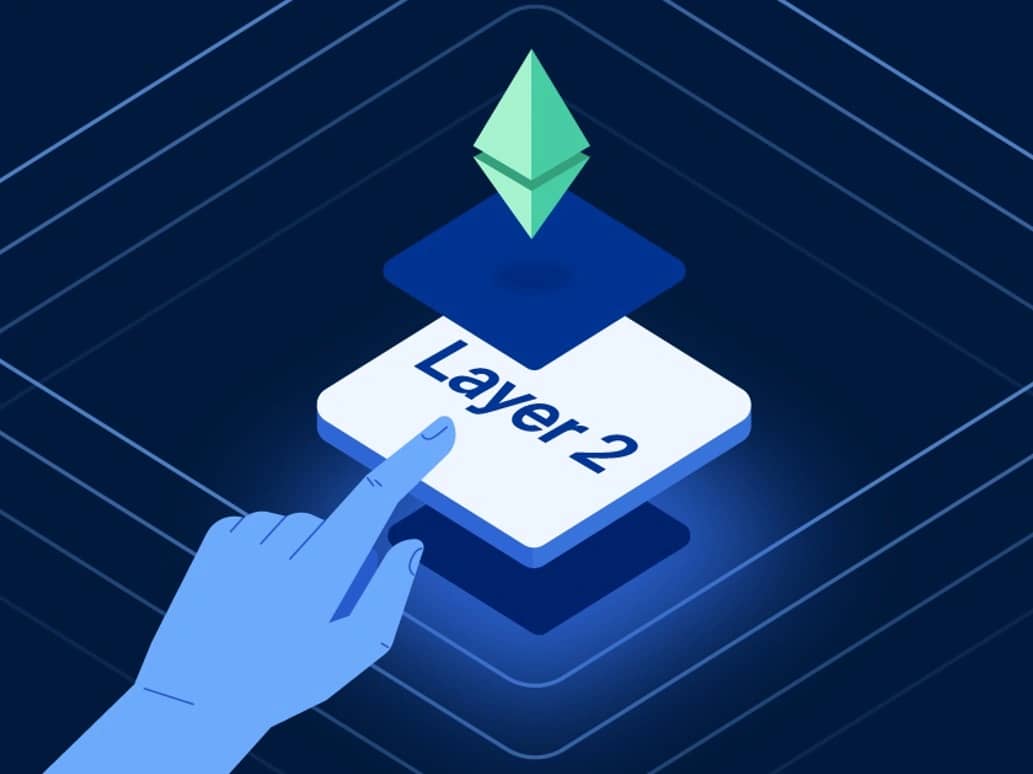订阅 wiki
Share wiki
Bookmark
Layer 2
Layer 2
Layer 2 (L2) 网络是一种链下扩展,它与底层 Layer 1 (L1) 区块链集成,以提高交易吞吐量。其主要重点是通过提供交易验证支持和从 Layer 1 卸载特定任务来优化区块链网络。值得注意的是,这些 L2 协议的安全性源于底层 L1 区块链的潜在强度。 [1][8]
概述
第一层区块链网络,如比特币和以太坊,在处理能力上受到限制,每秒只能处理少量交易(TPS)。这通常会导致网络拥堵和高gas费。为了提高这些网络的吞吐量并使其更具可扩展性,开发了第二层解决方案。 [2][3]
第二层网络,如Rollup和侧链,创建了一个二级框架,允许区块链交易和流程独立于主链进行。这使得它们成为“链下”扩展解决方案,可以提高区块链系统的整体效率和速度。 [4][5]
比特币的闪电网络通常被认为是最早的第二层扩展解决方案之一。它由Joseph Poon[22]和Thaddeus Dryja在2015年的白皮书中提出。闪电网络通过在链下进行大部分交易,并在必要时才在比特币区块链上结算,从而实现更快、更便宜的交易。 [5]
技术
第二层是区块链系统的一部分,负责快速处理交易。它有两个主要组成部分:处理交易的网络和一个智能合约,该合约通过将第二层网络连接到基础区块链来解决任何争议并就第二层网络的状态达成共识。[6]
尽管第二层网络实现吞吐量的方法差异很大,但它们都有一个共同的特征,即在主区块链上最终确定交易。为了确保任何建议的状态更改的可靠性,第二层解决方案必须向区块链提供加密且可验证的“证明”形式。不同的第二层解决方案的智能合约可能有所不同,但其核心功能保持一致:持有和释放转移到第二层的资金,验证第二层生成的证明,解决争议以及最终确定交易。Rollups、侧链、Plasma链和状态通道是第二层实现的一些示例。[6][9]
Rollups
Rollups 将多个交易捆绑成一个批次,然后提交到主区块链,以减少链上单个交易的数量。主要有两种类型的 Rollups:乐观 Rollups 和 零知识 Rollups (ZK Rollups)。这些 Rollups 通过链下执行智能合约状态的修改,然后通过证明在链上验证它们,从而提高吞吐量并降低成本。Rollups 通过实施以下三种方法来实现可扩展性:[7]
- 进行链下交易执行,这要求底层基础区块链仅执行小证明来验证网络活动并存储原始交易数据。
- 将交易数据批量提交到区块链,从而将链上 Gas 成本分摊到多个交易中。
- 需要至少存在一个诚实验证者来证明基础层区块链上交易的有效性。这使得可以在保持安全标准的同时,利用更小的 验证者 集合和更高的硬件需求。
侧链
侧链是连接到主链(例如比特币)的区块链网络,允许加密货币从主链开放转移到具有一定程度第三方信任的Layer 2链。它们通过支持L1区块链来验证交易,从而缓解主链因网络拥塞引起的问题。 [10][11]
侧链的关键方面
- 侧链是从主链派生的独立区块链网络。
- 它们经常使用双向锚定系统连接到主链。
- 侧链为推进扩展区块链技术的解决方案提供了机会。
- Polygon,以太坊的Layer 2解决方案,作为一个基于侧链概念的网络运行。 [12]
在标准侧链设置中,资产通过交易锁定在第一个区块链(主链)上。随后,在第二个区块链(侧链)上生成一个交易,并附带密码学证明,确认资产已在初始区块链上正确锁定。 [13]
Plasma
Plasma是由Vitalik Buterin和Joseph Poon[22]提出的Layer 2扩展解决方案,专为以太坊区块链设计。它涉及创建侧链(子链或Plasma链),这些侧链可以独立处理交易,并定期将摘要提交到以太坊主链。Plasma架构包含侧链的分层树,并且由于每个侧链都自主运行,与主链和其他侧链同时运行,因此最大限度地提高了速度和效率。[14]
状态通道
状态通道是两个用户之间建立的,旨在通过交易进行互动的通道。状态通道使参与者能够进行链下交易,并通过利用多重签名合约在主网上进行结算,这些合约要求多个参与方的签名才能执行。这种方法实现了高交易吞吐量,显著降低了拥堵和费用。 [14]
状态通道中的一个典型活动是由两个用户玩的井字游戏。在这里,“游戏逻辑”定义了游戏规则,而“状态逻辑”则跟踪游戏的当前状态。此外,它还根据游戏结果确定智能合约中资金的分配。状态通道机制允许在Layer 2平台上引入边玩边赚(P2E)游戏和各种去中心化应用程序(dApps),即使它们不是纯粹的金融应用。 [15]
Bitcoin Layer 2 Scaling Solutions
比特币Layer 2 扩展解决方案
闪电网络
闪电网络是最早的第二层扩展解决方案之一。它由 Joseph Poon 和 Thaddeus Dryja 在 2015 年的白皮书中提出。闪电网络通过链下进行大部分交易,仅在必要时才在比特币区块链上结算,从而实现更快、更便宜的交易。 [5][6]
它还为比特币引入了智能合约功能,显著增强了整个网络。闪电网络专注于提供即时支付、可扩展性、低成本和跨区块链交换。 [6]
Liquid 网络
Liquid 是一个在侧链上运行的结算网络,它与比特币的 Layer 2 基础设施集成。它连接了全球多个加密货币交易所和机构,从而能够实现更快、更私密的比特币交易。此外,Liquid 网络允许在 比特币 区块链上创建数字资产,例如 稳定币、证券型代币和其他金融工具。[16][17]
Liquid 网络为比特币交易所和交易者提供了多种功能,包括:[18]
- 快速、不可撤销的结算:转移到 Liquid 侧链的比特币 (L-BTC) 可以在短短两分钟内实现最终结算。
- 保密交易:Liquid 默认确保交易金额和资产类型的保密性,从而确保用户财务信息的安全。
- 安全的代币化:Liquid 侧链(已发行资产)允许创建代表法定货币、证券或其他数字资产的新代币,从而确保安全的代币化过程。
- 互操作性:单个 Liquid 集成提供对 L-BTC 和已发行资产的支持。所有代币都遵循相同的标准,使用户能够利用原子交换和比特币风格的多重签名等功能。
RootStock (RSK)
Rootstock (RSK) 是一个 Layer 2 EVM 兼容的 智能合约平台,它通过利用 比特币 作为其原生资产,解决了比特币区块链的特定限制。它作为一个无需许可的系统运行,采用一种称为合并挖矿工作量证明 (PoW) 的共识机制,目前有超过 50% 的比特币哈希算力在挖矿 Rootstock。这意味着 Rootstock 的挖矿哈希算力超过了除比特币本身之外的任何其他链。 [18][19]
RSK 与 以太坊 兼容,可以将以太坊智能合约迁移到其平台。通过转移这些合约,RSK 确保所有以太坊应用程序与比特币区块链的兼容性。 [21]
Ethereum Layer 2 扩容方案
Polygon
Polygon 是一种协议和框架,用于创建 Layer 2 区块链和侧链,它们与以太坊网络并行运行,同时与之交互。由于其与以太坊的兼容性,超过一千个去中心化应用程序 (dApp) 与 Polygon 链兼容。Polygon 技术包括以下内容:[6][7]
- Polygon PoS:一种与 EVM(以太坊虚拟机)兼容的侧链,使用权益证明 (PoS) 共识机制。
- Polygon zkEVM:一种零知识 EVM 兼容的 Layer 2 区块链,它使用 zk-STARK Rollup 并运行以太坊智能合约。
- Polygon Miden:它是一种基于 Starkware 的 zk-rollup,使用 zk-STARK。
- Polygon Nightfall:一种以隐私为中心的 Layer 2 区块链,它使用乐观 Rollup。建议用于 DAO 投票、私有 NFT 市场和供应链协调。
- Polygon Avail:一种独立的 Layer 2 链,用于存储与智能合约分离的交易数据。它通过解耦数据和执行层来工作。
Optimism
Optimism 是一个与 EVM 兼容的 乐观 rollup 链。它允许用户通过使用乐观 以太坊 网关在网络内外转移资产。此外,Optimism 可以在提交的表格获得批准后,在两周内将项目列入白名单。乐观以太坊 主网 上启动的一个项目示例是 Uniswap V3 Alpha 产品。 [6]
Arbitrum
Arbitrum 是一种 Layer 2 解决方案,旨在提高以太坊智能合约的速度和可扩展性。它包含额外的隐私功能,并声称是 DeFi 应用程序的最佳扩展解决方案,能够使用 Arbitrum rollup 来扩展任何以太坊合约。 [6]
发现错误了吗?
